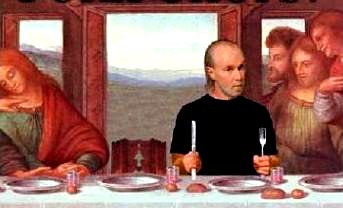Reciprocity in 2001
by Steven H. Cullinane
(May 30, 2001)
From 2001: A Space Odyssey, by Arthur C. Clarke, New American Library, 1968:
The glimmering rectangular shape that had once seemed no more than a slab of crystal still floated before him…. It encapsulated yet unfathomed secrets of space and time, but some at least he now understood and was able to command.
How obvious — how necessary — was that mathematical ratio of its sides, the quadratic sequence 1: 4: 9! And how naive to have imagined that the series ended at this point, in only three dimensions!
— Chapter 46, “Transformation”
From a review of Himmelfarb, by Michael Krüger, New York, George Braziller, 1994:
As a diffident, unsure young man, an inexperienced ethnologist, Richard was unable to travel through the Amazonian jungles unaided. His professor at Leipzig, a Nazi Party member (a bigot and a fool), suggested he recruit an experienced guide and companion, but warned him against collaborating with any Communists or Jews, since the objectivity of research would inevitably be tainted by such contact. Unfortunately, the only potential associate Richard can find in Sao Paulo is a man called Leo Himmelfarb, both a Communist (who fought in the Spanish Civil War) and a self-exiled Jew from Galicia, but someone who knows the forests intimately and can speak several of the native dialects.
“… Leo followed the principle of taking and giving, of learning and teaching, of listening and storytelling, in a word: of reciprocity, which I could not even imitate.”
… E. M. Forster famously advised his readers, “Only connect.” “Reciprocity” would be Michael Kruger’s succinct philosophy, with all that the word implies.
— William Boyd, New York Times Book Review, October 30, 1994
Reciprocity and Euler
Applying the above philosophy of reciprocity to the Arthur C. Clarke sequence
1, 4, 9, ….
we obtain the rather more interesting sequence
1/1, 1/4, 1/9, …..
This leads to the following problem (adapted from the St. Andrews biography of Euler):
Perhaps the result that brought Euler the most fame in his young days was his solution of what had become known as the Basel problem. This was to find a closed form for the sum of the infinite series
1/1 + 1/4 + 1/9 + 1/16 + 1/25 + …
— a problem which had defeated many of the top mathematicians including Jacob Bernoulli, Johann Bernoulli and Daniel Bernoulli. The problem had also been studied unsuccessfully by Leibniz, Stirling, de Moivre and others. Euler showed in 1735 that the series sums to (pi squared)/6. He generalized this series, now called zeta(2), to zeta functions of even numbers larger than two.
|





















 exist; if they do, they might ultimately play some role in the metaphysics of language.”
exist; if they do, they might ultimately play some role in the metaphysics of language.”




 in my previous entry. A check of
in my previous entry. A check of